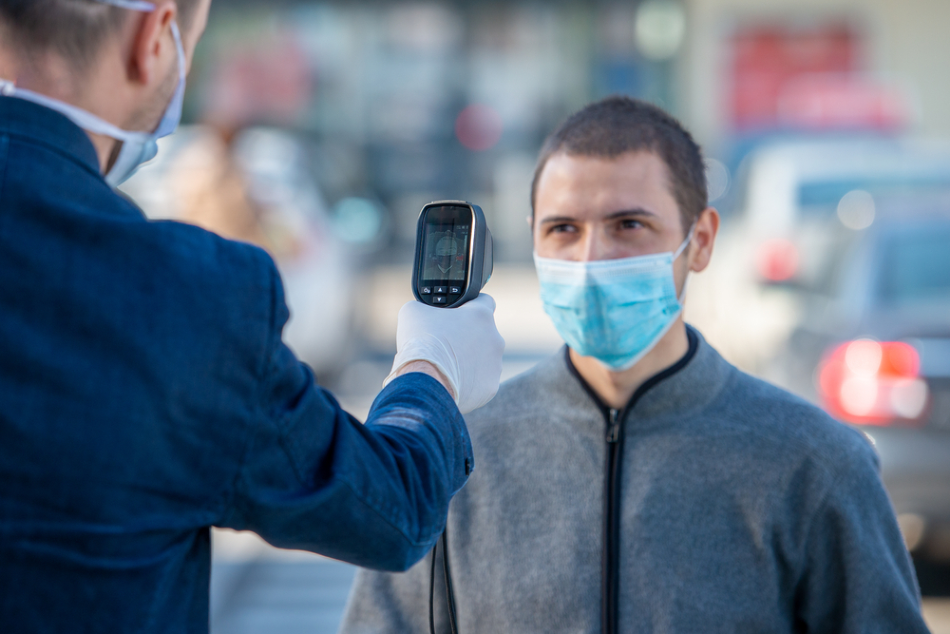
Image Credit: Pazargic Liviu/Shutterstock.com
When COVID-19 broke out around the world in the early months of 2020, many technological and low-tech solutions have been put forward to combat COVID-19 spread.
Among these solutions have been thermal infrared cameras, which are already widely used to detect the likelihood of fever in patients. But are these cameras effective at combating the spread of COVID-19?
Thermal Infrared Cameras: How do they Work?
Thermal imaging, thermal video, or infrared thermography (IRT) has been theoretically possible since the discovery of radiated energy emitting from all objects more than 300 years ago.
The black body radiation law states that all objects in the universe emit infrared radiation with a temperature that is higher than absolute zero. The subject of thermography emits this thermal energy.
Infrared thermal cameras detect emitted thermal energy instead of reflected light energy like standard photography cameras. A modified charge-coupled device (CCD) or complementary metal-oxide-semiconductor (CMOS) sensors combined with off-the-shelf closed-circuit television (CCTV) devices are able to detect this.
Specialist infrared thermal cameras include focal plane arrays (FPAs) that detect longer wavelengths than entry-level equipment, which detects energy on the near-infrared (NIR) spectrum. Microbolometers are currently used as FPA sensors due to their relatively low cost and no requirements for ambient temperature cooling.
Infrared thermal cameras must also include an output option for displaying the information they record. This can be through recording a digital file (or film) for analysis on a separate device later, or through a screen embedded within the thermal infrared camera. A thermogram displays the information with various ranges of temperature as different colors on the image.
Infrared thermal cameras typically have much lower resolution than optical cameras. The majority are 160 x 120 or 320 x 240 pixels, with high-resolutions up to 1280 x 1024 only possible with considerable expense.
Since the 1950s, thermal infrared cameras are used in numerous medical settings. They were initially used to monitor increased heat over arthritic patients’ hips, and in the treatment of Raynaud’s phenomenon, diabetes and melanoma.
The most common medical application of thermal infrared cameras is in fever screening and diagnosis. Mercury thermometers have been replaced by thermal infrared cameras, which take a reading from the patient’s eardrum (tympanic temperature). This measurement is a good indicator of whether a patient has a fever, but can thermal infrared cameras be used against the COVID-19 spread?
Read more: The infrared cameras on the market today
Infrared Thermal Cameras and COVID-19 Spread
Thermal infrared cameras have already been deployed around the world in government and public health attempts to stop the COVID-19 spread.
In these applications, the infrared thermal camera display is customized to ensure temperatures even one or two degrees above the safe level of 37 ℃ automatically show as red in the thermogram.
The key to using thermal infrared cameras to prevent COVID-19 spread is their effective placement and operation. Contrary to the claims of some usuppliers, thermal infrared cameras cannot accurately detect the temperature of more than one object at once.
Furthermore, the camera must be positioned approximately one meter away from the subject. The latest advice after the Swine Flu outbreak is that the cameras should record an image in as high-resolution as possible from just under the subject’s tear ducts. Before the Swine Flu, thermal imaging cameras were directed at the forehead, often delivering erroneous results.
Although thermal infrared cameras monitor fevers, this is with tympanic devices which cannot be used while simultaneously maintaining social distance. Passive screening with facial infrared thermal cameras must be supported by further assessment before diagnoses can be reached.
All of this means that passive temperature scanning with thermal infrared cameras is relatively ineffective at stopping the spread of COVID-19. Furthermore, fevers are not always present in those infected with this strain of coronavirus.
Therefore, alone, thermal infrared cameras are not effective in combating COVID-19 spread. However, used in conjunction with large-scale testing and tracing, social distancing, face-masking and hand-washing, they can be a useful – although limited – part of our COVID-19 spread prevention strategies.
References and Further Reading
Herman, C. (2013) The Role of Dynamic Infrared Imaging in Melanoma Diagnosis. Expert Review of Dermatology. https://doi.org/10.1586/edm.13.15.
Ng, Eddie YK, and Mahnaz Etehadtavakol, eds. (2017) Application of Infrared to Biomedical Sciences. Series in BioEngineering. Springer Singapore. https://doi.org/10.1007/978-981-10-3147-2.
Medicines and Healthcare products Regulatory Agency (2020) Don’t rely on temperature screening products for detection of coronavirus (COVID-19), says MHRA. Gov.uk. https://www.gov.uk/government/news/dont-rely-on-temperature-screening-products-for-detection-of-coronavirus-covid-19-says-mhra.
Ring, Francis (2015) Infrared Imaging. IOP Publishing. ISBN: 978-0-7503-1144-1.
Disclaimer: The views expressed here are those of the author expressed in their private capacity and do not necessarily represent the views of AZoM.com Limited T/A AZoNetwork the owner and operator of this website. This disclaimer forms part of the Terms and conditions of use of this website.